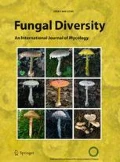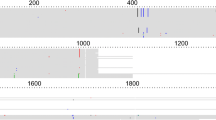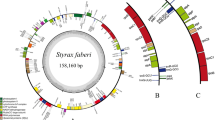Abstract
The phylogeny of Phylloporus (Boletaceae) has not been well studied, and the taxonomic relationships of this genus have varied considerably among authors. The following study presents phylogenetic relationships of Phylloporus based on two nuclear ribosomal DNA regions, ITS and LSU. The ITS dataset includes 39 collections and the LSU dataset contains 50 collections of Phylloporus. A combined analysis of both genes did not resolve the deeper nodes in the phylogeny, but the results suggest that Phylloporus is monophyletic and a sister group of the Xerocomus subtomentosus group. The lamellate hymenophore configuration is a synapomorphy that distinguishes Phylloporus from the other genera in the family. The placement of a lamellate genus within Boletaceae suggests that hymenophore evolution is not well understood in the family. This is the first phylogeny of Phylloporus and includes 20 species from different geographic regions. Six taxa of Phylloporus from the Old World are here presented. Phylloporus cyanescens is a new combination for an Australasian taxon formerly named as a variety of P. bellus (Massee) Corner. Phylloporus pumilus is described from Indonesia, and 4 species are described from Thailand: P. castanopsidis, P. dimorphus, P. infuscatus, and P. rubiginosus.








Similar content being viewed by others
References
Besl H, Bresinsky A (1997) Chemosystematics of Suillaceae and Gomphidiaceae (suborder Suillineae). Plant Systemat Evol 206:223–242
Bessette AE, Roody WC, Bessette AR (2000) North American boletes: a color guide to the fleshy pored mushrooms. Syracuse University Press, USA
Binder M (1999) Zur molekularen systematik der Boletales: Boletineae und Sclerodermatineae subordo nov. Ph.D. University of Regensburg
Binder M, Bresinsky A (2002) Derivation of a polymorphic lineage of Gasteromycetes from boletoid ancestors. Mycologia 94:85–98
Binder M, Hibbett DS (2006) Molecular systematics and biological diversification of Boletales. Mycologia 98:971–981
Bresinsky A, Besl H (2003) Beiträge zu einer Mykoflora Deutschlands: Schlüssel zur Gattungsbestimmung der Blätter-Leisten- und Röhrenpilze. Regensburger Mykologische Schriften 11:5–236
Bresinsky A, Jarosch M, Fischer M, Schonberger I, Wittmann-Bresinsky B (1999) Phylogenetic relationships within Paxillus s.l. (Basidiomycetes, Boletales): separation of a Southern hemisphere genus. Plant Biol 1:327–333
Corner EJH (1970) Phylloporus Quél. and Paxillus Fr. in Malaya and Borneo. Nova Hedwigia 20:793–822
Corner EJH (1972) Boletus in Malaysia. Government Printing Office, Singapore
Corner EJH (1974) Boletus and Phylloporus in Malaysia: further notes and descriptions. The Gardens’ Bulletin, Singapore 27:1–16
Dallwitz MJ (1980) A general system for coding taxonomic descriptions. Taxon 29:41–46
Dallwitz MJ, Paine TA, Zurcher EJ (1993) onwards. User’s guide to the DELTA system: a general system for processing taxonomic descriptions.
Gardes M, Bruns TD (1993) ITS primers with enhanced specificity for basidiomycetes–application to the identification of mycorrhizae and rusts. Mol Ecol 2:113
Grubisha LC, Trappe JM, Molina R, Spatafora JW (2001) Biology of the ectomycorrhizal genus Rhizopogon. V. Phylogenetic relationships in the Boletales inferred from LSU rDNA sequences. Mycologia 93:82–89
Halling RE (2001) Ectomycorrhizae: co-evolution, significance, and biogeography. Ann Mo Bot Gard 88:5–13
Halling RE, Mueller GM (2002) Agarics and boletes of neotropical oakwoods. In: Watling R, Frankland JC, Ainsworth AM, Isaac S, Robinson CH (eds) Tropical mycology, vol 1. CAB International, UK, pp 1–10
Heinemann P, Rammeloo J (1986) Phylloporus (Boletineae). Flore Illustreé des Champignons d’Afrique Centrale 13:277–309
Heinemann P, Rammeloo J (1987a) Novitates generis Phyllopori (Boletineae). Bulletin du Jardin Botanique National de Belgique 57:272–274
Heinemann P, Rammeloo J (1987b) Phylloporus (Boletineae). Flore Illustreé des Champignons d’Afrique Centrale 13:277–309
Huelsenbeck JP, Ronquist FR (2001) MrBayes: Bayesian inference of phylogeny. Bioinformatics 17:754–755
Kornerup A, Wanscher JH (1978) Methuen Handbook of colour, 3rd edn. Methuen Co, London
Ladurner H, Simonini G (2003) Xerocomus s.l, vol 8. Edizioni Candusso, Alassio
Largent DL (1986) How to identify mushrooms to genus I: macroscopic features. I, vol 2. Mad River Press Inc, Eureka
Largent DL, Johnson D, Watling R (1977) How to identify mushrooms to Genus III: microscopic features, 3rd edn. Mad River Press Inc., Eureka
Li Y-C, Feng B, Yang ZL (2011) Zangia, a new genus of Boletaceae supported by molecular and morphological evidence. Fungal Divers 49:125–143
Maddison WP, Maddison DR (2005) MacClade: analysis of phylogeny and character evolution. Sinauer Associates, Sunderland
Moncalvo J-M, Lutzoni FM, Rehner SA, Johnson J, Vilgalys R (2000) Phylogenetic relationships of agaric fungi based on nuclear large subunit ribosomal DNA sequences. Syst Biol 49:278–305
Moncalvo J-M, Vilgalys R, Redhead SA, Johnson JE, James TY, Aime MC, Hofstetter V, Verduin SJW, Larsson E, Baroni TJ, Thorn RG, Jacobsson S, Clémençon H, Miller OKJ (2002) One hundred and seventeen Clades of Euagarics. Mol Phylogenet Evol 23:357–400
Montoya L, Bandala VM (1991) Studies on the genus Phylloporus in Mexico. I. Discussion of the known species and description of a new species and a new record. Mycotaxon 41:471–482
Neves MA, Halling RE (2010) Study on species of Phylloporus. I - Neotropics and North America. Mycologia 102:944–966
Pegler DN, Young TWK (1981) A natural arrangement of the Boletales, with reference to spore morphology. Trans Br Mycol Soc 76:103–146
Peintner U, Ladurner H, Simonini G (2003) Xerocomus cisalpinus sp. nov., and the delimitation of species in the X. chrysenteron complex based on morphology and rDNA-LSU sequences. Mycol Res 107:659–679
Posada D, Crandall KA (1998) Modeltest: testing the model of DNA substitution. Bioinformatics Appl 14:817–818
Singer R (1945) The Boletineae of Florida with notes on extralimital species. II. the Boletaceae (Gyroporoideae). Farlowia 2:223–303
Singer R (1978) Notes on Bolete taxonomy II. Persoonia 9:421–438
Singer R, Gómez LD (1984) The Basidiomycetes of Costa Rica. III. The genus Phylloporus (Boletaceae). Brenesia 22:163–181
Singer R, Ovrebo CL, Halling RE (1990) New species of Phylloporus and Tricholomopsis from Colombia, with notes on Phylloporus boletinoides. Mycologia 82:452–459
Smith AH, Thiers HD (1971) The Boletes of Michigan. ed. University of Michigan Press, Ann Arbor
Sutara J (2008) Xerocomus s. l. in the light of the present state of knowledge. Czech Mycol 60:29–62
Swofford DL (2002) PAUP*. Phylogenetic analysis using parsimony (*and other methods), version 4.0b10 (Altivec). Sinauer Associates, Sunderland
Taylor AFS, Hills AE, Simonini G, Both EE, Eberhardt U (2006) Detection of species within the Xerocomus subtomentosus complex in Europe using rDNA–ITS sequences. Mycol Res 110:276–287
Thiers, B. (2012). Index Herbariorum: a global directory of public herbaria and associated staff. New York Botanical Garden’s Virtual Herbarium. http://sweetgum.nybg.org/ih/ (continuously updated)
Thompson JD, Gibson TJ, Plewniak F, Jenmougin F, Higgins DG (1997) The CLUSTAL X windows interface: flexible strategies for multiple sequence alignment aided by quality analysis tools. Nucleic Acids Res 24:4876–4882
Vilgalys R, Hester M (1990) Rapid genetic identification and mapping of enzimatically amplifiedribosomal DNA from several Cryptococcus species. J Bacteriol 172:4238–4246
Watling R (2008) A manual and source book on the boletes and their allies, 24th edn. Fungiflora, Oslo
Watling R, Gregory NM (1991) Observations of the boletes of the Cooloola Sandmass, Queensland and notes on their distribution in Australia. Part 3. Lamellate taxa. Edinb J Bot 48:353–391
White TJ, Bruns TD, Lee S, Taylor JW (1990) Amplification and direct sequencing of fungal ribosomal RNA genes for phylogenetics. In: Innis MA, Gelfand DH, Sninsky JJ, White TJ (eds) PCR protocols: a guide to methods and applications. Academic Press, San Diego, pp 315–322
Zeng NK, Tang L-P, Yang ZL (2011) Type studies on two species of Phylloporus (Boletaceae, Boletales) described from southwestern China. Mycotaxon 117:19–28. http://dx.doi.org/10.5248/117.19
Zeng NK, Yang ZL (2011) Notes on two species of Boletellus (Boletaceae, Boletales). Mycotaxon 115:413–423
Acknowledgements
The first author thanks Coordenação de Aperfeiçoamento de Pessoal de Nível Superior (CAPES, Brasil) for the financial support during her PhD. The authors are grateful to the National Science Foundation for partial support from grants BSR-8600424, DEB-9300798, DEB-9972018, and DEB-0414665 awarded to Roy Halling, as well as DEB-0444531 awarded to Manfred Binder and David Hibbett. Thanks to the Mushroom Research Centre in Chiang Mai (Thailand) and Dennis Desjardin (San Francisco State University) for a fieldwork opportunity. We thank the curators and individuals that made collections available for this study: Ana Esperanza Franco-Molano (HUA), Dennis Desjardin (SFSU), Don Pfister (FH), Eric McKenzie (PDD), Greg Mueller (F), Rosana Maziero, Slavomir Adamovcik. Nathan Smith made helpful comments on the manuscript. The contribution of K.S. and King Mongkut’s Institute of Technology in providing REH with a Material Transfer Agreement to study Thai bolete specimens is gratefully appreciated.
Author information
Authors and Affiliations
Corresponding author
Rights and permissions
About this article
Cite this article
Neves, M.A., Binder, M., Halling, R. et al. The phylogeny of selected Phylloporus species, inferred from NUC-LSU and ITS sequences, and descriptions of new species from the Old World. Fungal Diversity 55, 109–123 (2012). https://doi.org/10.1007/s13225-012-0154-0
Received:
Accepted:
Published:
Issue Date:
DOI: https://doi.org/10.1007/s13225-012-0154-0




